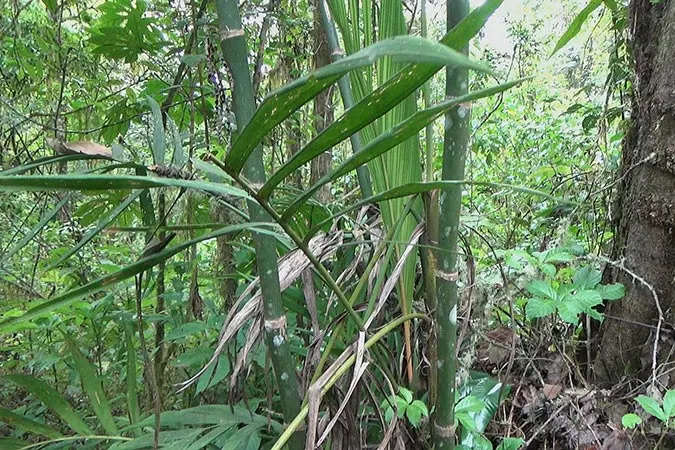Pinang Jawa or Javan pinang (Pinanga javana) is a species of plant in Arecaceae, stems erect, 4-10 meters high, 10-15 cm in diameter, 10-30 cm in segments, the surface of the stem is green or brownish green, smooth, slightly longitudinally slit. The crown axis is elongated, 150-200 cm long, 25 cm in diameter, swollen, purplish brown with brown scales and grows at an elevation of 800-1700 meters.
P. javana has 10 leaves on the crown, pinnate, full length 250-300 cm with silvery indumentum on petiole and rachis. Midrib up to 100 cm, stalk up to 30 cm, concave at the adaxial and convex at the bottom.
Rachis diameter 3 cm. Leaflets 10-15 items on each side of the rachis, regularly arranged, slightly curved, longitudinally linear-lanceolate, falcate-sigmoid, equidistant, basal leaflet 65-95x1-6 cm and 1-3 ribs, middle leaflet 70-115x2.7 cm and 1-3 ribs, apical leaflets 19-55x1.5-7.5 cm and 2-7 ribs.
Infrafoliar inflorescences, like hands, pendulous spreading, 40-50 cm long, peduncle erect at base, flattened, 9-16 cm long, 0.8-1.5 cm thick. Racillae 8-13 items, arranged alternately, 23-35 cm at base with 19-21 triads, at apex 18-27 cm with 15-17 triads, peduncle, rachis and racillae green when young or bright red with age.
The petals and crown are cream in color and the ovary is green. Petals cup-shaped, 3 sepals, imbricate, broad orbicular, 6-8x4-4.5 mm, smooth, thick in the middle, thin on the sides with ciliated edges, apex mucronate. Corolla with 3 ciliate petals, cucullate round, 4-6x3-4 mm, apex mucronate-blunt.
Fruit ovate to ellipsoidal, 20-26x11-14 mm, pale light yellow or red when young, dark red when ripe then black, dense fibrous pericarp, thin endocarp, membrane. Seeds ovate to ellipsoidal, 18-21x10-13 mm, deep rumination.
Kingdom: Plantae
Phylum: Tracheophyta
Subphylum: Angiospermae
Class: Liliopsida
Order: Arecales
Family: Arecaceae
Subfamily: Arecoideae
Genus: Pinanga
Species: Pinanga javana
P. javana has 10 leaves on the crown, pinnate, full length 250-300 cm with silvery indumentum on petiole and rachis. Midrib up to 100 cm, stalk up to 30 cm, concave at the adaxial and convex at the bottom.
Rachis diameter 3 cm. Leaflets 10-15 items on each side of the rachis, regularly arranged, slightly curved, longitudinally linear-lanceolate, falcate-sigmoid, equidistant, basal leaflet 65-95x1-6 cm and 1-3 ribs, middle leaflet 70-115x2.7 cm and 1-3 ribs, apical leaflets 19-55x1.5-7.5 cm and 2-7 ribs.
Infrafoliar inflorescences, like hands, pendulous spreading, 40-50 cm long, peduncle erect at base, flattened, 9-16 cm long, 0.8-1.5 cm thick. Racillae 8-13 items, arranged alternately, 23-35 cm at base with 19-21 triads, at apex 18-27 cm with 15-17 triads, peduncle, rachis and racillae green when young or bright red with age.
The petals and crown are cream in color and the ovary is green. Petals cup-shaped, 3 sepals, imbricate, broad orbicular, 6-8x4-4.5 mm, smooth, thick in the middle, thin on the sides with ciliated edges, apex mucronate. Corolla with 3 ciliate petals, cucullate round, 4-6x3-4 mm, apex mucronate-blunt.
Fruit ovate to ellipsoidal, 20-26x11-14 mm, pale light yellow or red when young, dark red when ripe then black, dense fibrous pericarp, thin endocarp, membrane. Seeds ovate to ellipsoidal, 18-21x10-13 mm, deep rumination.
Kingdom: Plantae
Phylum: Tracheophyta
Subphylum: Angiospermae
Class: Liliopsida
Order: Arecales
Family: Arecaceae
Subfamily: Arecoideae
Genus: Pinanga
Species: Pinanga javana
